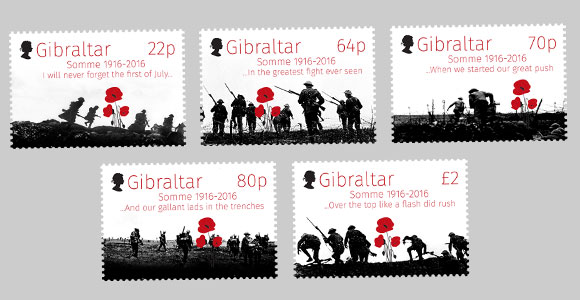Home -> Stamps -> 2016 -> 100th Anni. Battle of the Somme
We also recommend:
100th Anni. Battle of the Somme

100th Anni. Battle of the Somme (view technical specs)
The Battle of the Somme was a battle of the First World War fought by the armies of the British and French empires against the German Empire. It took place between 1 July and 18 November 1916 on both sides of the River Somme in France.
It was one of the largest battles of World War I, in which more than 1,000,000 men were wounded or killed, making it one of the bloodiest battles in human history. A Franco-British commitment to an offensive on the Somme had been made during Allied discussions at Chantilly, Oise, in December 1915. The Allies agreed upon a strategy of combined offensives against the Central Powers in 1916, by the French, Russian, British and Italian armies, with the Somme offensive as the Franco-British contribution. The main part of the offensive was to be made by the French army, supported on the northern flank by the Fourth Army of the British Expeditionary Force (BEF).
When the German Army began the Battle of Verdun on the Meuse on 21 February 1916, many French divisions intended for the Somme were diverted and the supporting attack by the British became the principal effort. The first day on the Somme (1 July) was a serious defeat for the German Second Army, which was forced out of its first position by the French Sixth Army, from Foucaucourt-en-Santerre south of the Somme to Maricourt on the north bank and by the Fourth Army from Maricourt to the vicinity of the Albert–Bapaume road. The first day on the Somme was also the worst day in the history of the British army, which had c. 57,470 casualties, mainly on the front between the Albert–Bapaume road and Gommecourt, where the attack was defeated and few British troops reached the German front line. The British army on the Somme was a mixture of the remains of the pre-war regular army, the Territorial Force and the Kitchener Army, which was composed of Pals battalions, recruited from the same places and occupations.
The battle is notable for the importance of air power and the first use of the tank. At the end of the battle, British and French forces had penetrated 6 miles (9.7 km) into German-occupied territory, taking more ground than any offensive since the Battle of the Marne in 1914. The Anglo-French armies failed to capture Péronne and were still 3 miles (4.8 km) from Bapaume, where the German armies maintained their positions over the winter. British attacks in the Ancre valley resumed in January 1917 and forced the Germans into local withdrawals to reserve lines in February, before the scheduled retirement to the Siegfriedstellung (Hindenburg Line) began in March. The battle remains controversial over its necessity, significance and effect. (wikipedia.com)
Technical Specs
| Design: | Stephen Perera |
| Illustration / Photography: | Hulton archive; IVM/Getty Images; Windmill Books |
| Printer: | Cartor Security Printers, France |
| Process: | Offset lithography |
| Colours: | 4 cols. |
| Stamp size: | 42 x 28mm |
| Issue date: | 2016-05-16 |
| Stamp Values: | 22p, 64p, 70p, 80p, £2 |













